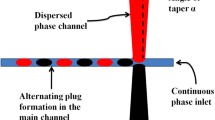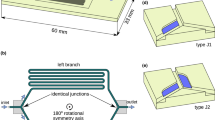Abstract
A theoretical model is derived mathematically for the encoding and controlling of the navigating of two droplet trains in a microfluidic network with a loop-like structure. The model reveals the relationship between the new outlet droplet train’s arrangement information (output signals) and the parameters including the two droplet trains’ input signals (droplet intervals), tuning flow rates, etc. The theoretical results are compared with the experimental results and they agree with each other. We find that every tuning flow rate corresponds to a certain output signal and a new droplet train can be obtained accurately. The generation orders of the successive droplets of the new droplet train remain unchanged within a certain range of the tuning flow rates. This work can be a useful reference for traffic controlling of two or more droplet trains in many microfluidic networks including the loop structure; the output signal of this work can be the input one for the next level which makes the multilevel studies possible. In addition, this study can help to promote the effective fusion of droplets and further the biological and chemical applications on droplet microfluidics.










Similar content being viewed by others
References
Ahn K, Agresti J, Chong H, Marquez M, Weitz DA (2006) Electrocoalescence of drops synchronized by size-dependent flow in microfluidic channels. Appl Phys Lett 88:264105
Ajdari A (2004) Steady flows in networks of microfluidic channels: building on the analogy with electric circuits. C R Phys 5:539–546
Anna SL, Bontoux N, Stone HA (2003) Formation of dispersions using “flow focusing” in microchannels. Appl Phys Lett 82:364–366
Barbier V, Willaime H, Tabeling P (2006) Producing droplets in parallel microfluidic systems. Phys Rev E 74:046306
Behzad MD, Seyed-Allaei H, Ejtehadi MR (2010) Simulation of droplet trains in microfluidic networks. Phys Rev E 82:037303
Belloul M, Engl W, Colin A, Panizza P, Ajdari A (2009) Competition between local collisions and collective hydrodynamic feedback controls traffic flows in microfluidic networks. Phys Rev Lett 102:194502
Bithi SS, Vanapalli SA (2010) Behavior of a train of droplets in a fluidic network with hydrodynamic traps. Biomicrofluidics 4:044110
Bogojevic D, Chamberlain MD, Barbulovic-Nad I, Wheeler AR (2012) A digital microfluidic method for multiplexed cell-based apoptosis assays. Lab Chip 12:627–634
Bremond N, Thiam AR, Bibette J (2008) Decompressing emulsion droplets favors coalescence. Phys Rev Lett 100:024501
Bretherton F (1961) The motion of long bubbles in tubes. J Fluid Mech 10(2):166–188
Brouzes E, Medkova M, Savenelli N, Marran D, Twardowski M, Hutchison JB, Rothberg JM, Link DR, Perrimon N, Samuels ML (2009) Droplet microfluidic technology for single-cell high-throughput screening. PNAS 106:14195–14200
Chen G, Tan P, Chen S, Huang J, Wen W, Xu L (2013) Coalescence of pickering emulsion droplets induced by an electric field. Phys Rev Lett 110:064502
Cristobal G, Benoit J-P, Joanicot M, Ajdari A (2006) Microfluidic bypass for efficient passive regulation of droplet traffic at a junction. Appl Phys Lett 89:034104
Cybulski O, Garstecki P (2010) Dynamic memory in a microfluidic system of droplets traveling through a simple network of microchannels. Lab Chip 10:484–493
Engl W, Roche M, Colin A, Panizza P, Ajdari A (2005) Droplet traffic at a simple junction at low capillary numbers. Phys Rev Lett 95:208304
Fu T, Ma Y, Li HZ (2014) Hydrodynamic feedback on bubble breakup at a T-junction within an asymmetric loop. AIChE J 60(5):1920–1929
Fuerstman MJ, Garstecki P, Whitesides GM (2007) Coding/decoding and reversibility of droplet trains in microfluidic networks. Science 315:828–832
Garstecki P (2010) Microfluidics based microsystems: fundamentals and applications. Springer, Netherlands
Garstecki P, Fuerstman MJ, Whitesides GM (2005) Oscillations with uniquely long periods in a microfluidic bubble generator. Nat Phys 1:168–171
Glawder T, Elbuken C, Ren C (2011) Passive droplet trafficking at microfluidic junctions under geometric and flow asymmetries. Lab Chip 11:3774–3784
Gleichmann N, Malsch D, Horbert P, Henkel T (2014) Toward microfluidic design automation: a new system simulation toolkit for the in silico evaluation of droplet-based lab-on-a-chip systems. Microfluid Nanofluid 18:1095–1105
Hashimoto M, Whitesides GM (2010) Formation of bubbles in a multisection flow-focusing junction. Small 6:1051–1059
Huebner A, Srisa-Art M, Holt D, Abell C, Hollfelder F, de Mello AJ, Edel JB (2007) Quantitative detection of protein expression in single cells using droplet microfluidics. Chem Commun 12:1218–1220
Jeanneret R, Vest J-P, Bartolo D (2012) Hamiltonian traffic dynamics in microfluidic-loop networks. Phys Rev Lett 108:034501
Jousse F, Farr R, Link DR, Fuerstman MJ, Garstecki P (2006) Bifurcation of droplet flows within capillaries. Phys Rev E 74:036311
Labrot V, Schindler M, Guillot P, Colin A, Joanicot M (2009) Extracting the hydrodynamic resistance of droplets from their behavior in microchannel networks. Biomicrofluidics 3(1):257–265
Link DR, Anna SL, Weitz DA, Stone HA (2004) Geometrically mediated breakup of drops in microfluidic devices. Phys Rev Lett 92:054503
Link DR, Grasland-Mongrain E, Duri A, Sarrazin F, Cheng Z, Cristobal G, Marquez M, Weitz DA (2006) Electric control of droplets in microfluidic devices. Angew Chem 45(16):2556–2560
Liu K, Deng Y, Zhang N, Li S, Ding H, Guo F, Liu W, Guo S, Zhao X-Z (2012) Generation of disk-like beads for cell encapsulation and manipulation using a droplet-based microfluidic device. Microfluid Nanofluid 13:761–767
Maddala J, Wang WS, Vanapalli SA, Rengaswamy R (2013) Traffic of pairs of drops in microfluidic ladder networks with fore-aft structural asymmetry. Microfluid Nanofluid 14:337–344
Mazutis L, Griffiths AD (2009) Preparation of monodisperse emulsions by hydrodynamic size fractionation. Appl Phys Lett 95:204103
Mazutis L, Baret J-C, Griffiths AD (2009) A fast and efficient microfluidic system for highly selective one-to-one droplet fusion. Lab Chip 9:2665–2672
Miller OJ, El Harrak A, Mangeat T, Baret J-C, Frenz L, El Debs B, Mayot E, Samuels ML, Rooney EK, Dieu P, Galvan M, Link DR, Griffiths AD (2012) High-resolution dose–response screening using droplet-based microfluidics. PNAS 109:378–383
Mostowfi F, Khristov K, Czarnecki J, Masliyah J, Bhattacharjee S (2007) Electric field mediated breakdown of thin liquid films separating microscopic emulsion droplets. Appl Phys Lett 90:184102
Murran MA, Najjaran H (2012) Direct current pulse train actuation to enhance droplet control in digital microfluidics. Appl Phys Lett 101:144102
Niu X, Gulati S, Edel JB, deMello AJ (2008) Pillar-induced droplet merging in microfluidic circuits. Lab Chip 8:1837–1841
Niu X, Gielen F, deMello AJ, Edel JB (2009) Electro-coalescence of digitally controlled droplets. Anal Chem 81:7321–7325
Okushima S, Nisisako T, Torii T, Higuchi T (2004) Controlled production of monodisperse double emulsions by two-step droplet breakup in microfluidic devices. Langmuir 20(23):9905–9908
Park C-W, Homsy G (1984) Two-phase displacement in Hele Shaw cells: theory. J Fluid Mech 139(1):291–308
Prakash M, Gershenfeld N (2007) Microfluidic bubble logic. Science 315:832–835
Salkin L, Schmit A, Courbin L, Panizza P (2013) Passive breakups of isolated drops and one-dimensional assemblies of drops in microfluidic geometries: experiments and models. Lab Chip 13(15):3022–3032
Schindler M, Ajdari A (2008) Droplet traffic in microfluidic networks: a simple model for understanding and designing. Phys Rev Lett 100:044501
Sessoms DA, Belloul M, Engl W, Roche M, Courbin L, Panizza P (2009) Droplet motion in microfluidic networks: hydrodynamic interactions and pressure-drop measurements. Phys Rev E 80:016317
Sessoms DA, Amon A, Courbin L, Panizza P (2010) Complex dynamics of droplet traffic in a bifurcating microfluidic channel: periodicity, multistability, and selection rules. Phys Rev Lett 105:154501
Singh P, Aubry N (2007) Transport and deformation of droplets in a microdevice using dielectrophoresis. Electrophoresis 28:644–657
Smith BJ, Gaver DP (2010) Agent-based simulations of complex droplet pattern formation in a two-branch microfluidic network. Lab Chip 10:303–312
Song H, Tice JD, Ismagilov RF (2003) A microfluidic system for controlling reaction networks in time. Angew Chem 42:768–772
Song K, Zhang L, Hu G (2012) Modeling of droplet traffic in interconnected microfluidic ladder devices. Electrophoresis 33:411–418
Takinoue M, Takeuchi S (2011) Droplet microfluidics for the study of artificial cells. Anal Bioanal Chem 400:1705–1716
Thorsen T, Roberts RW, Arnold FH, Quake SR (2001) Dynamic pattern formation in a vesicle-generating microfluidic device. Phys Rev Lett 86:4163–4166
Wang W, Yang C, Li CM (2009) On-demand microfluidic droplet trapping and fusion for on-chip static droplet assays. Lab Chip 9:1504–1506
Willaime H, Barbier V, Kloul L, Maine S, Tabeling P (2006) Arnold tongues in a microfluidic drop emitter. Phys Rev Lett 96:054501
Wong H, Radke C, Morris S (1995) The motion of long bubbles in polygonal capillaries. Part 1. Thin films. J Fluid Mech 292:71–94
Wu Y, Fu T, Zhu C, Ma Y, Li HZ (2012) Asymmetrical breakup of bubbles at a microfluidic T-junction divergence: feedback effect of bubble collision. Microfluid Nanofluid 13:723–733
Wu Y, Fu T, Zhu C, Ma Y, Li HZ (2014) Bubble coalescence at a microfluidic T-junction convergence: from colliding to squeezing. Microfluid Nanofluid 16(1–2):275–286
Yamada M, Doi S, Maenaka H, Yasuda M, Seki M (2008) Hydrodynamic control of droplet division in bifurcating microchannel and its application to particle synthesis. J Colloid Interface Sci 321:401–407
Zagnoni M, Baroud CN, Cooper JM (2009) Electrically initiated upstream coalescence cascade of droplets in a microfluidic flow. Phys Rev E 80:046303
Zanella A, Biral A (2014) Design and analysis of a microfluidic bus network with bypass channels. IEEE International Conference on Communications 3993–3998
Zheng B, Tice JD, Ismagilov RF (2004) Formation of droplets of alternating composition in microfluidic channels and applications to indexing of concentrations in droplet-based assays. Anal Chem 76:4977–4982
Zhou H, Yao S (2013) Electrostatic charging and control of droplets in microfluidic devices. Lab Chip 13:962–969
Acknowledgments
The authors would like to acknowledge the support from the Hunan Provincial Natural Science Foundation for Young Scholars (No. 2015JJ3121), the Scientific Research Foundation of Xiangtan University (Nos. 13KZ|KZ08022 and 13KZ|KZ08029) and the National Natural Science Foundation of China (No. 11272321) for this work.
Author information
Authors and Affiliations
Corresponding author
Electronic supplementary material
Below is the link to the electronic supplementary material.
Appendices
Appendix 1: Droplet intervals in the dilution or concentration modules
Figure 11 below is a simple network, and it is also a dilution or concentration module as Sessoms et al. (2009). One droplet train moves from channel 1 whose cross section is S 1 to channel 2 whose cross section is S 2, the slip factors of droplets equal to β 1 and β 2, respectively. The flow rate of channel 1 is Q c1, and the flow rate of channel 2 is \(Q_{c1} + Q_{c2}\) after dilution. Q c2 can be minus, but all the droplets from channel 1 will go through channel 2.
For the module, we assume that droplets entering frequency is f 1 while droplets exit frequency is f 2 . The velocities of channel 1 and 2 are calculated as below:
After Δt time, the entering droplet number is \(f_{1} \varDelta t\), and the exit droplet number is \(f_{2} \varDelta t\). Meanwhile, the distance of any droplet from channel 1 and 2 is:
If we let λ 1 and λ 2 represent the space intervals between droplets which traffic in channel 1 and 2, respectively, then we have:
We can get f 1 and f 2 from Eq. (23):
When droplets traffic in a microfluidic network, all the droplets number in the network will be stable under a stable traffic state. That is to say: f 1 = f 2. Combining with Eq. (24), we have:
If the microchannels’ cross sections are equal to S and the slip factors of droplets in the microchannels are equal to β (Bithi and Vanapalli 2010; Jeanneret et al. 2012), we have:
Appendix 2: Droplet number in branch A and branch B
The total hydrodynamic resistances for branches A, B and C are (n C = 0):
We also know that:
Combining with Eqs. (8), (10) and (27), we have:
where the coefficients above are as follows:
Substituting Eq. (29) into Eq. (28) yields
Finally, n A and n B can be got by solving Eq. (31).
Rights and permissions
About this article
Cite this article
Song, K., Hu, G., Hu, X. et al. Encoding and controlling of two droplet trains in a microfluidic network with the loop-like structure. Microfluid Nanofluid 19, 1363–1375 (2015). https://doi.org/10.1007/s10404-015-1651-8
Received:
Accepted:
Published:
Issue Date:
DOI: https://doi.org/10.1007/s10404-015-1651-8





